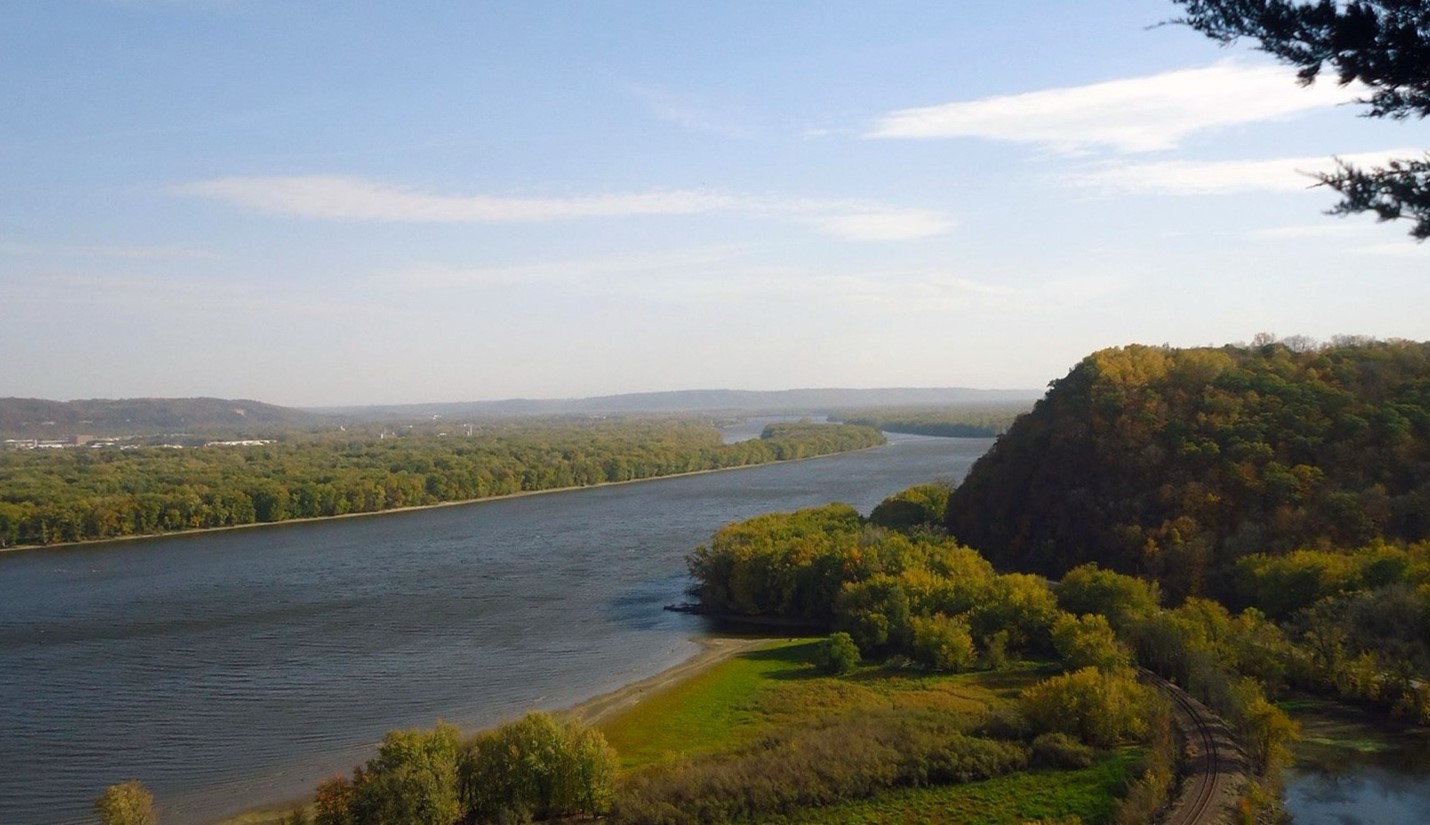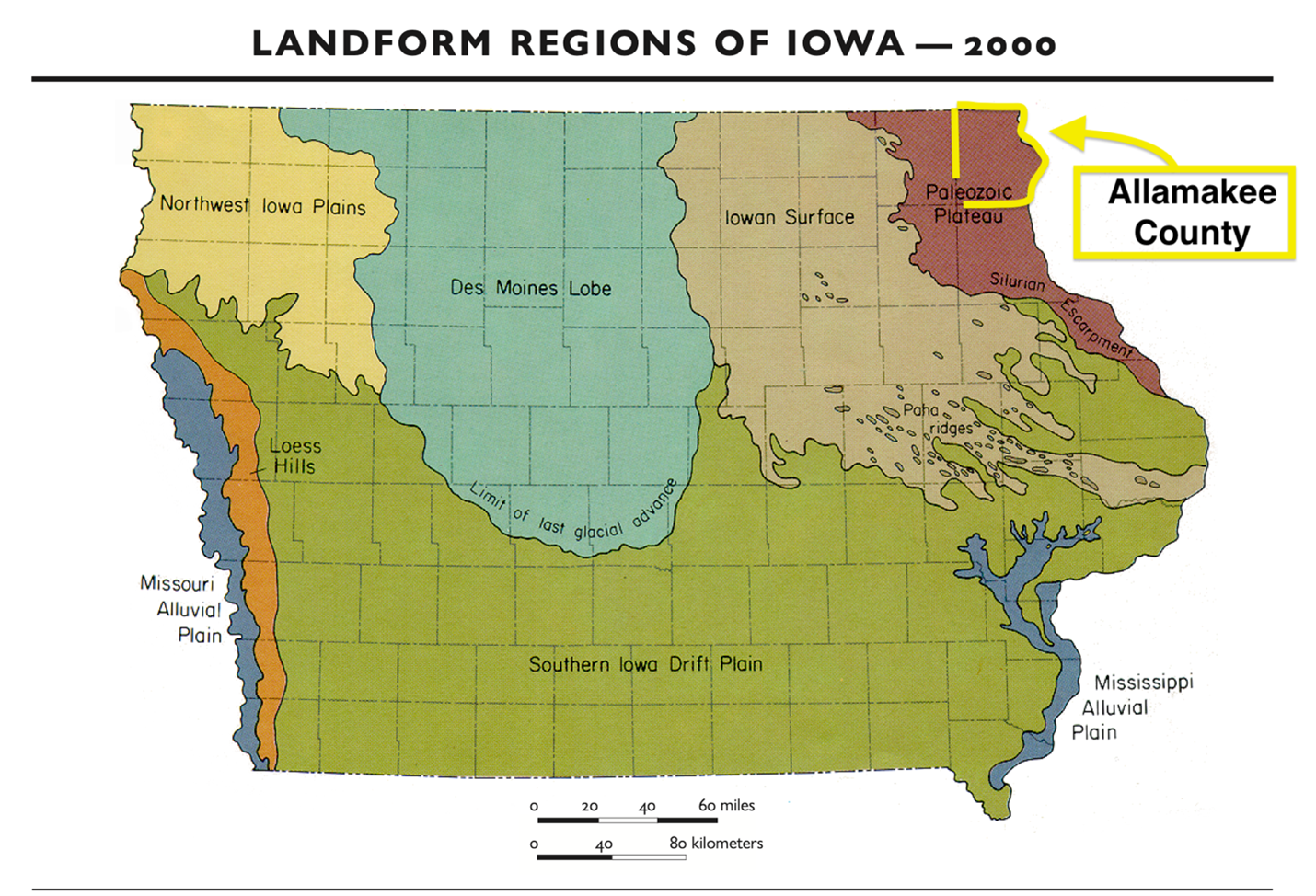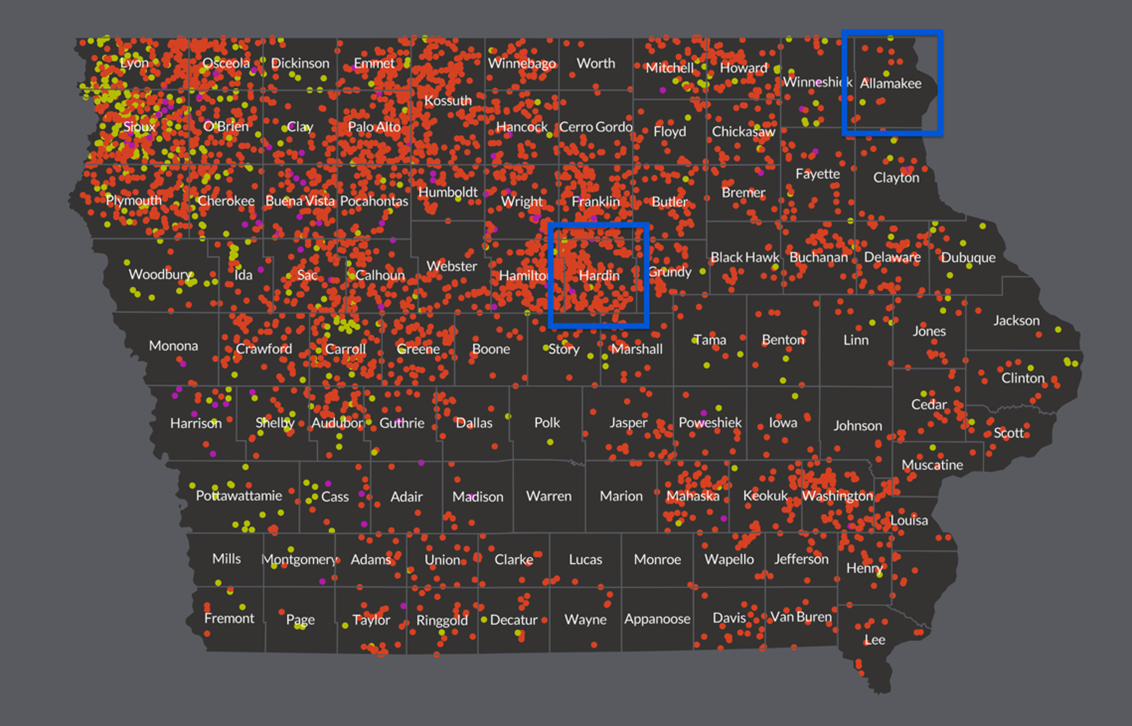Challenging Land Use and Abuse in Allamakee County
by Dave Rollo

Limestone bluffs tower above the upper Mississippi River at Effigy Mounds in Allamakee County Iowa (Yinan Chen, Wikimedia Commons).
Allamakee County lies in the northeast corner of Iowa, bordering Minnesota and Wisconsin. It is part of a three-state region that, unlike most of the upper United States and Canada, escaped glaciation during past ice ages. This geological oddity is immediately obvious to visitors by the dramatic terrain of bluffs, hills, and valleys. Expansive plains characterize most of the rest of Iowa, where miles-thick glaciers moved over the land like a bulldozer, lowering elevated areas, filling in depressions, and depositing rich, deep till.
In contrast, the unglaciated northeast of Iowa, referred to as the Paleozoic Plateau for the geologic era of ancient sea bed limestones visible at the surface, contains thin soils and exposed bedrock.

Allamakee County lies in the Paleozoic Plateau (brown shaded) region of Iowa (The University of Iowa, Iowa Geological Survey).
Allamakee County has benefitted from the rugged environment of forests and streams. Its natural beauty and ecological diversity underpin a local economy of tourism, hunting, and trout fishing. Allamakee County is sparsely populated, with a historically stable number of 14,000 residents. Residents understand that their county’s sustainability depends on preserving its natural endowment. Local leaders have been responsive to citizen desire to protect the county’s attributes. In 2021, they developed a comprehensive plan that integrates sustainable design and protection of natural and agricultural resources.
Nonetheless, Allamakee County struggles against the forces of growth that exploit the land, threaten its groundwater, and endanger residents’ health. First among these forces are Confined Animal Feeding Operations (CAFOs). The county’s new-found mineral resources have also attracted extractive mining interests. Given the unique geology of the region, both of these operations render vital aquifers susceptible to pollution.
Citizens have effectively resisted these ongoing risks—pushing back against Big Ag and mining. Their policies and plans serve as a model for the rest of the state. They demonstrate what a small number of determined citizens can do to safeguard their county.
Imperiled Aquifers
Historically, Iowa featured vast, biodiverse tall-grass prairies and savannas over the western 80 percent of the state. Grasslands with mixed hardwood and conifer forest interspersed with prairie covered the remaining northeastern area of the state. With human settlement and subsequent conversion of natural systems to agriculture, only 0.1 percent of prairies and less than half the forests remain. Most of those forests are found in the northeast, afforded some protection by the rugged hills.

Map indicating locations of CAFOs in Iowa in 2019 (Environmental Working Group Report, “Big CAFOs in Iowa Up Fivefold Since 1990”). Hardin County and Allamakee County are highlighted. Copyright © Environmental Working Group, www.ewg.org. Reproduced with permission.
Nowadays, Iowa is the most intensely developed state for agribusiness crops. It ranks first for corn production—double that of Nebraska (which holds second place)—and second in soybean production. Much of those crops are used as animal feed for the enormous CAFO industry. Here, Iowa again ranks first, with the CAFO industry having quintupled in size since 1990. Iowa now has the ignominious distinction of having 20 percent of the total CAFOs in the United States. In 2024 there were more than seven hogs in Iowa for every resident. One CAFO alone in Iowa houses a confined hog population almost twice the human population of Allamakee County.
Urine and fecal waste from such a massive number of animals cannot be safely applied to enrich agricultural fields. Instead, they end up in vast holding ponds. Combined with the fertilizer required for crops—especially the yearly 2.5 billion-bushel corn harvest that demands 1 lb. of nitrogen per bushel—Iowa watersheds, streams, and groundwater are subject to enormous levels of ammonium and nitrate contamination. This is due to leakage and overflow of leachate from animal waste lagoons and runoff from fields. Such nitrogen pollution results in algal blooms that harm aquatic ecosystems. Nitrate is also implicated in adverse human health impacts, including cancers. It is no wonder that the majority of streams in Iowa are regarded as “impaired” by the state DNR. Only 24 percent of stream segments are considered “healthy.”

Maps indicating specific private wells tested in Allamakee County where contaminants were found (Environmental Working Group and Iowa Environment Council, “Iowa’s Private Wells Contaminated by Nitrate and Bacteria”). Copyright © Environmental Working Group, www.ewg.org. Reproduced with permission.
This has resulted in well contamination throughout the state. A study conducted by the Environmental Working Group in 2019 revealed widespread private well contamination throughout Iowa. Scientists identified agriculture as the source of dangerous levels of both bacteria and nitrate.
While all of Iowa is threatened by industrial farming practices, aquifers in regions with thick glacial till are afforded a buffer through their clay-rich soils that absorb and retain pollutants. In contrast, the thin soils of the Paleozoic Plateau afford little buffer. Its limestone bedrock, known as karst, is also much more porous, with dissolved cavities that allow pollutant runoff to readily enter groundwater. This explains how, despite Allamakee County’s relatively low number of twelve CAFOs, it has five times more contaminated wells than the similarly sized county of Hardin, which has nearly 500 CAFOs but is located within the central Iowa till plain.
A Line in the Sand

Frac sand mining operation (Wikideas1, Wikimedia Commons).
Allamakee County is rich in resources, and one in particular became intensely sought after in the past decade. As a consequence of the unique geology of the Paleozoic Plateau, silica sand with an unusual purity and uniform grain size is found there in abundance. The sand is particularly suited for fracking—the process of hydraulically shattering deep shale to liberate oil and natural gas. Sand is used with the injection of fluids to keep the cracks in the shale open. This permits the continued flow of liquid oil or natural gas once the shale has been perforated.
Sand industries sought leases in the county, but the citizenry organized quickly when they learned of the proposals. Sand mining would not only scar the land. Processing the sand for fracking would also compound Allamakee’s existing farm runoff problem by leaching industrial chemicals into the groundwater. The sand industry also causes lung health hazards for fenceline communities. Breathing in tiny silica particles can lead to permanent lung impairment, such as silicosis and cancer. Citizens rallied, forming the Allamakee County Protectors in opposition to the proposal.
Citizens Push Back
Ric Zarwell, former President of the Allamakee County Protectors and local conservationist and birder, recounts the local struggle against frac sand mining. Residents were fortunate to be working with officials in local government who actively solicited public opinion. These included several County Supervisors and the Allamakee Planning & Zoning Administrator. “We brought in specialists with frac sand mining and visited mining sites in Wisconsin,” Zarwell describes. “It was plainly apparent what damage and health risks the process causes.” Despite very active lobbying by the mining company, Minnesota Sands, and endorsements by boosters in major newspapers, the opposition to three proposed leases won a moratorium by county government in a 2013 meeting attended by 200 county residents. In mid-2014, the additional time for organizing that this hiatus allowed paid off. The County Board of Supervisors adopted what is considered to be the strictest frac sand mining ordinance in the country.
Allamakee County’s efforts extend well beyond their locale. Over the last decades, their efforts, such as working on water quality with a goal of zero impaired waterways, and a Bluffland Protection Ordinance (to prevent any development on steep slopes), have inspired others to protect their farmland and communities from devastating and lasting effects. They have also inspired an ongoing conversation about the ecological tradeoffs made in favor of an industry that is sure to only provide a temporary economic boon.
After their success against frac sand mining, the Protectors began organizing to prevent further CAFOs in Allamakee County. Perhaps in anticipation of this organized resistance, industry petitioners only proposed one CAFO in Allamakee from 2011 to 2019. When the industry requested a permit for a 7,499 hog CAFO, the group challenged the size and location. The state DNR recommended against the CAFO. But because of what Zarwell describes as woefully inadequate state regulations, the state approved the permit in 2016, ignoring its own officials’ warnings. In the final permit, the operation was downsized to 2,499 pigs. But this could just as easily represent the industry’s attempt to escape regulations as a grassroots victory. (Smaller CAFOs are more lightly regulated). Such is the power of the industry in Iowa, where the jurisdiction lies at the state level.
In February 2024, citizen organizations joined forces to petition the DNR and EPA to tighten rules for CAFO operations. Allamakee County Protectors were among the members of this coalition to push for tighter regulation of CAFO operations sited on karst bedrock. Ten organizations protested rules that they find wholly inadequate for protecting citizens and the environment in Iowa. Summarized by Michael Schmidt, Director of the Iowa Environmental Council: “These rules will perpetuate poor water quality.”
All in Allamakee
Allamakee County has developed a model of citizen participation in the planning process through its comprehensive plan, designated “All in Allamakee.” The county included residents in the planning through an inclusive process labeled “appreciative inquiry,” which seeks to build on the successes of the community to direct future efforts. Surveys of Allamakee County residents demonstrate high levels of concern and respect for their natural surroundings. More than three quarters of resident feedback rank the creation of protected lands as their highest preference. The comprehensive plan translated this feedback into a strong policy emphasis on preserving and protecting local land.
Despite the receptivity of the county government to resident concerns, and the reverence that the plan demonstrates toward its local land, the county possesses very scant power to mitigate the worst CAFO impacts. Local government bodies only have advisory power when it comes to decisions about siting and size of proposed CAFOs, as well as to their subsequent regulation. Ultimately, the DNR has the final word over these decisions, as well as their regulatory enforcement, meaning that locals lack any binding power over CAFO siting decisions. Even if they did have power over these decisions in their own county, most of Iowa shares a connected single aquifer, making Allamakee County highly susceptible to pollution by CAFOs in the rest of the state.

The Jordan Aquifer is a shared groundwater resource for all Iowans (Ground Water Atlas of the United States, USGS).
Ric Zarwell attributes Allamakee County’s limited ability to defend itself against pollution from CAFOs to the industry’s regulatory capture of the state house. “The Farm Bureau controls the legislature,” he says. The governor’s recent rejection of new rules for protection of karst, because they would not lower the “regulatory burden” on the livestock companies, is a potent validation of the severity of this problem. Furthermore, the state adopted a controversial bill, SF2370, into law this past May, which systematizes this destructive logic by preempting the passage of any laws that would strengthen the CAFO regulatory framework. Zarwell argues it will require a united, state-wide grassroots effort to loosen the stranglehold of industry control.
CAFO’s state regulatory capture is a formidable Goliath for the 14,000 residents of Allamakee County to tackle. Still, despite these setbacks, citizen groups continue pushing for action. Zarwell believes advocates’ best recourse is to lobby for a moratorium on factory farm approvals in the state. Efforts are underway for such a moratorium. House File 2124 would prevent “new construction or expansion of structures in confinement feeding operations.” The bill has some support in the current election cycle. We will see on November 5th whether the state elects candidates who will put their weight behind this kind of steady-state legislation.
Advocates should be clear-eyed about the power of the CAFO lobby. House File 2124 is crucial to advocate for, even if it has a good chance of being defeated. Only with this kind of statewide, sustained grassroots pressure do we stand a chance of springing a few leaks into the bedrock of the CAFO industry’s political control.
Dave Rollo is a policy specialist and team leader of the Keep Our Counties Great campaign at CASSE.

Leave a Reply
Want to join the discussion?Feel free to contribute!
(No profanity, lewdness, or libel.)